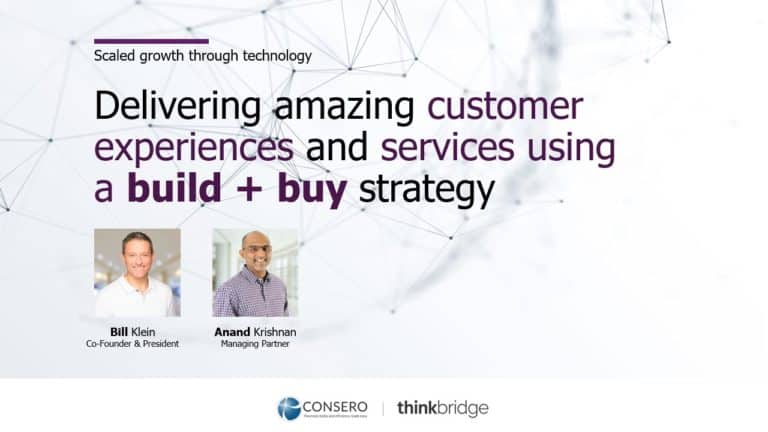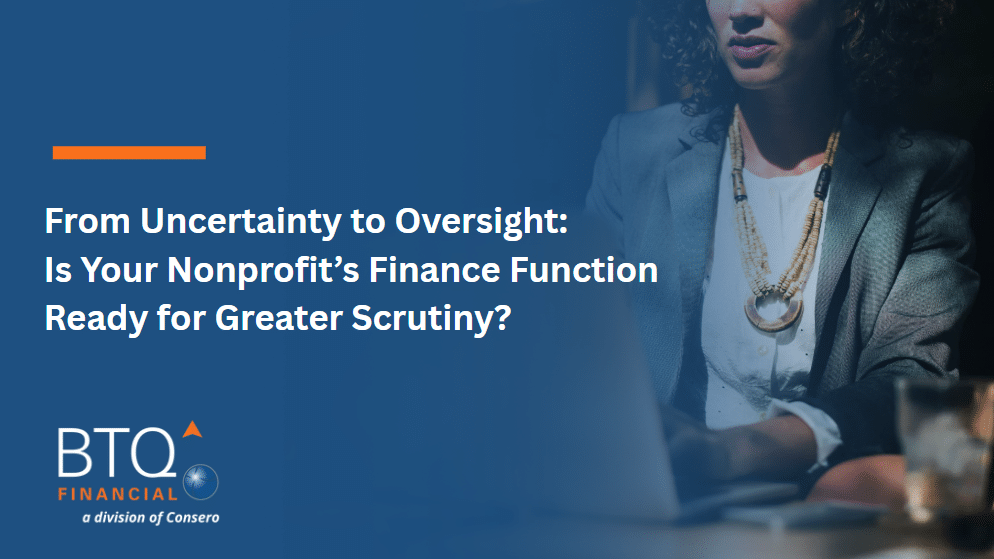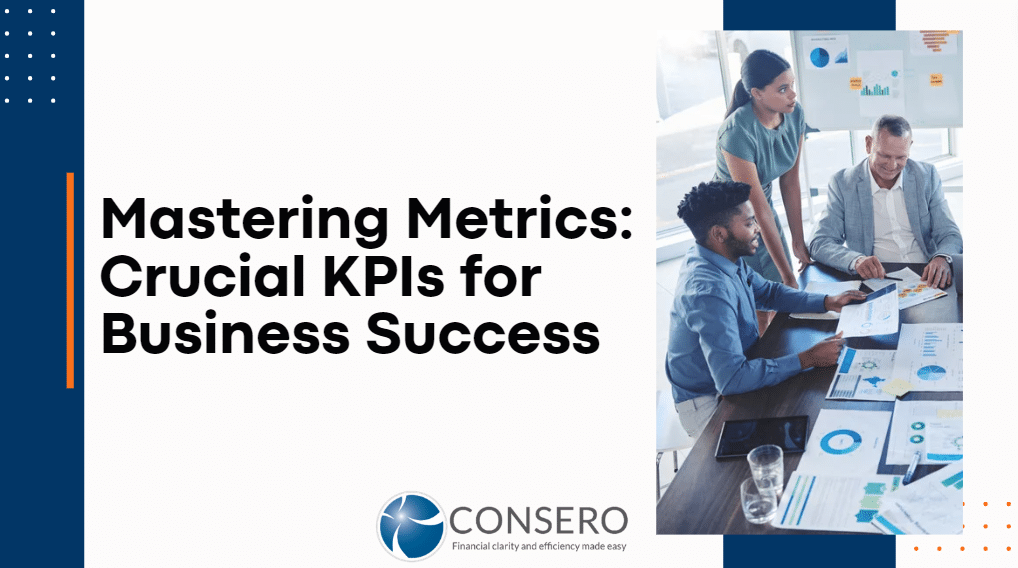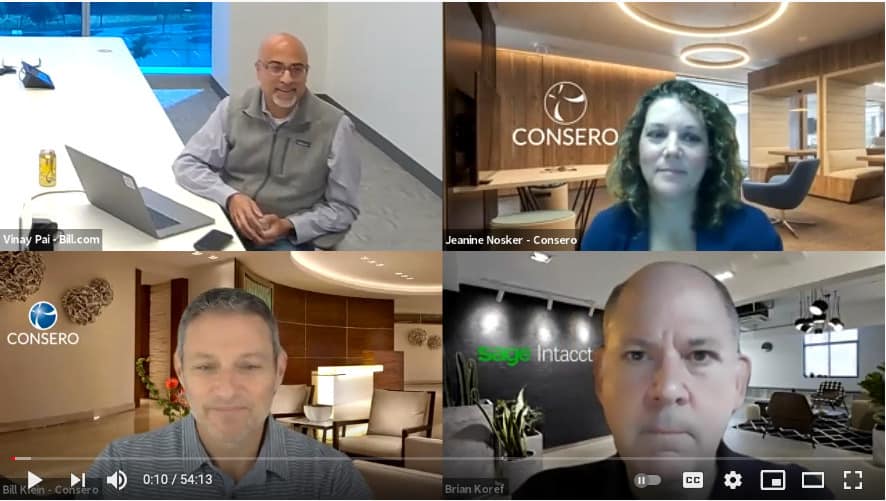
How can growth-stage companies integrate multiple SaaS products and still deliver an exceptional customer experience?
Bill Klein, Co-Founder of Consero and entrepreneur with over 20 years of technology and services experience, and Anand Krishnan, Managing Partner of thinkbridge, seed investor, and technologist focused on helping growth stage companies become technology companies, discuss the “Build + Buy” strategy.
The strategy balances purchasing best-in-class SaaS solutions with custom-built elements to enhance customer and employee experiences, offering a path to deliver exceptional services while maintaining differentiation.
The SaaS Landscape
The proliferation of SaaS products designed to address specific niche problems creates an increasingly complex technological environment for businesses.
While these solutions offer specialized capabilities, managing these disparate systems often results in fragmentation and inefficiency.
Challenges:
- The ease of purchasing and deploying SaaS solutions via “click-and-buy” methods inadvertently adds complexity as more solutions are added
- Overwhelming volume of available products; the fear of missing out on solutions competitors might be using.
- Switching between platforms after deep investment is a significant hurdle, making initial product vetting crucial.
The Shift from Traditional Monoliths to Specialized SaaS Solutions
Traditionally, large enterprises relied on monolithic, expensive, and time-consuming-to-implement enterprise resource planning (ERP) systems like SAP and Oracle.
Today, the market has shifted towards specialized SaaS products, each focusing on a fraction of the functionality offered by older systems but with expanded capabilities for their specific use cases.
Key Takeaways:
- Large traditional systems are highly customizable but expensive and complex.
- Modern SaaS platforms offer less customization but lower upfront costs.
- Choosing and transitioning between platforms is costly and time-consuming.
| Traditional Large-Scale Systems | Modern SaaS Products |
|---|---|
| Cost & Implementation | |
|
|
| Functionality & Customization | |
| Extensive customization capabilities but defined best practices limit differentiation opportunities |
|
Despite the abundance of specialized SaaS solutions, many businesses still rely on ubiquitous Excel spreadsheets as a “master” source of information due to data fragmentation across systems.
“Just when you think that’s all you need, you realise you’re running 20-plus platforms and still keeping a master Excel sheet to make sense of it all.”
Differentiation through Customer Experience
Growth-stage businesses need to differentiate themselves to stand out in a crowded marketplace, which can’t be achieved by purchasing and relying on off-the-shelf software.
“You can’t buy your way to differentiation. You can’t just buy Salesforce and say, ‘I can service you better because we have Salesforce.’ 20,000 other customers, or businesses can say the exact same thing.”
Instead, cultivating unique customer and employee experiences that reflect cultural DNA is the recommended pathway to differentiation.
“Customer experience is your cultural DNA, not your software vendor’s…you can’t delegate that customer experience to your software products.”
Key Takeaways:
- Operational processes and customer interactions should drive software selection, rather than adapting processes to fit purchased software.
- Core CX and EX differentiating elements are built on top, while specialized functionalities are bought from best-in-class providers.
The Build + Buy Strategy
The Build + Buy strategy means purchasing best-in-class SaaS platforms for core functionalities and then building a custom “unification layer” on top that delivers consistent and personalized experiences.
This unification layer serves two purposes:
- A digital customer experience platform, providing a branded and seamless interaction point.
- An employee experience platform, preventing employees from having to log into numerous disparate systems.
The growing availability of microservices and APIs (like, Twilio for SMS, Stripe for payments) makes it easier than ever for businesses to build custom differentiating layers on top of purchased services.
Key Takeaways:
Purchase existing SaaS solutions for common operational tasks (payments, CRM, payroll) instead of reinventing these standardized functions.
Focus development resources only on the layer that differentiates you: your unique customer and employee experience.
Modern API and micro-service ecosystems (e.g., Twilio, Stripe) make this approach both feasible and cost-effective to implement.
This approach future-proofs the technology stack: you can swap back-end tools without disrupting the front-end experience.
Build + Buy Case Study: Consero’s SIMPL Platform
Consero’s Finance as a Service (FaaS) model delivers all software and services necessary for a company’s financial operations, including bill payment, customer billing, cash application, and monthly book closing.
Consero delivers FaaS through the SIMPL platform, a custom-built software layer that sits on top of various third-party applications (e.g., Sage Intacct, Bill.com), to simplify customer interaction with the finance function.
SIMPL abstracts the complexity of the underlying third-party finance and accounting applications with a unified, simplified interface for customers and internal teams to:
This layered approach allows Consero to:
- Standardize on underlying application
- Ensure clients receive expertise + out-of-the-box solutions for common challenges (like multi-currency support for international offices).
Internally, Consero’s employees can leverage leading third-party applications and custom automation to manage their workload more efficiently and provide higher-value services to customers.
The SIMPL Layer
Abstracts complexity: clients see cash, A/R, approvals, KPIs in one unified interface.
Standardizes onboarding + speed to optimization: new clients go live with institutional-grade reporting in 30–90 days, not 6-18 months.
Enables swap-outs: Consero can migrate from Sage to NetSuite without altering the client portal.
Supports pay-per-service pricing: costs scale smoothly with headcount.
Real-time transparency: executives check cash or variances without waiting for the “wizard in the box.”
Elastic cost structure: expenses flex with business size instead of step-function hires.
“Since we launched SIMPL, customers no longer log into four finance tools and wonder why A/R says ‘0’—they see exactly what matters, in one place,” said Klein.
How to Build + Buy
Implementing Build + Buy demands clear roles and governance to align people, processes, and tools.
- Visionaries identify CX opportunities.
- Pragmatists translate vision into platform requirements.
- Doers integrate APIs, workflows and data pipelines.
- Tooling spans connectors, automation, monitoring and secure infrastructure.
Clear organizational roles facilitate effective technology implementation, while businesses strategically manage tools and processes to support unified digital experiences.
Mistakes
Strategic Takeaways
Tools alone don’t create competitive advantage.
Don’t outsource your brand’s unique CX/EX personality to SaaS products.
Pair best-of-breed systems of record with a home-grown unification layer to prioritize customization of differentiators and stay agile as the SaaS market evolves.
The Build + Buy strategy reframes digital transformation: buy for parity, build for uniqueness.
By following Consero’s example—standardising core apps while building a proprietary engagement layer—growth companies can offer a “single pane of glass” that delights customers and liberates employees, even as their SaaS stack inevitably changes.







